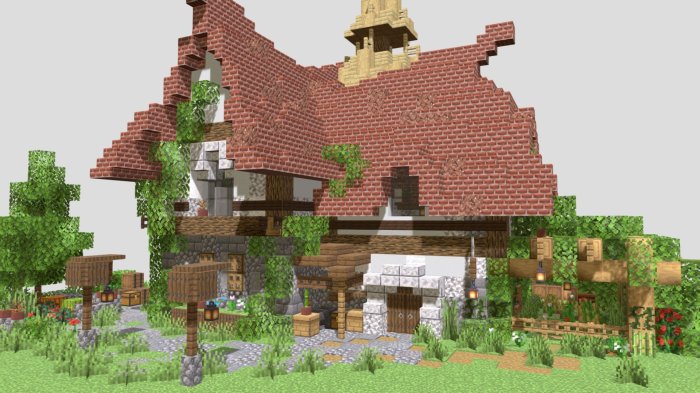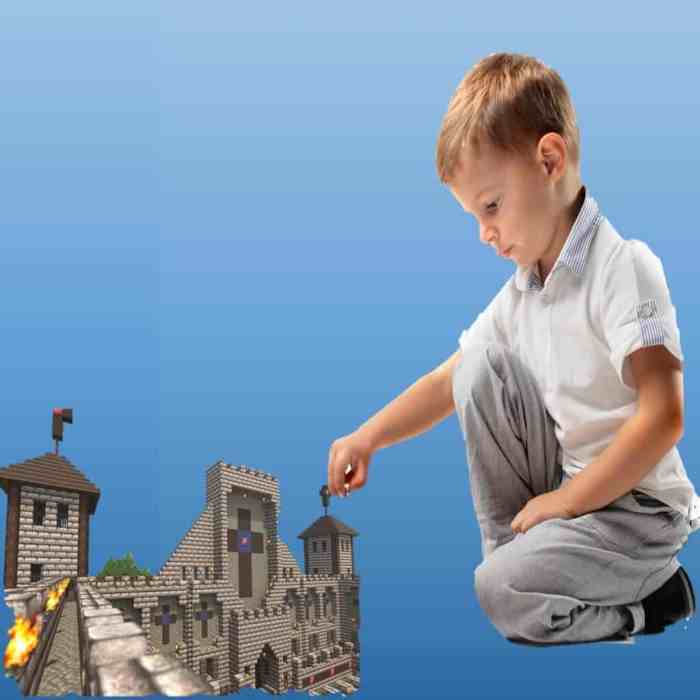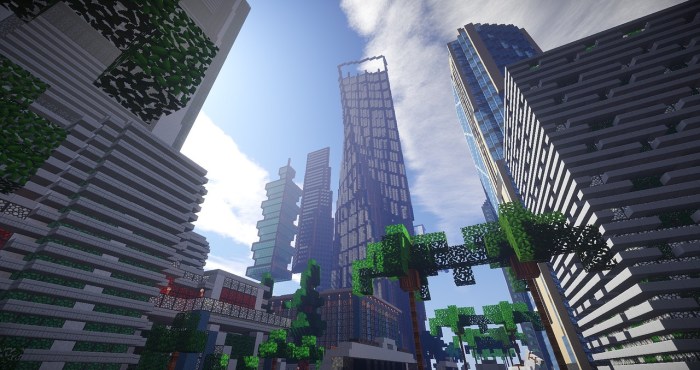Using 3D Minecraft to Teach Architecture and Geometry opens a world of creative possibilities for learning. Beyond its status as a popular video game, Minecraft’s block-based environment provides a unique platform for exploring architectural concepts and geometric principles in a hands-on, engaging way.
Students can build intricate structures, experiment with different shapes and patterns, and even learn about complex geometric concepts like symmetry, area, and volume.
The beauty of Minecraft lies in its ability to bridge the gap between digital and physical worlds, making learning fun and interactive. This unique approach allows students to translate their understanding of architectural and geometric principles into tangible creations, fostering a deeper understanding and appreciation for these subjects.
Introduction
Minecraft, a sandbox video game, has gained immense popularity among players of all ages. Its open-world environment and creative freedom have made it a beloved platform for learning and exploration. The game’s block-based construction system allows users to build anything they can imagine, fostering creativity and problem-solving skills.
This unique feature makes Minecraft a valuable tool for teaching architecture and geometry.The ability to visualize and manipulate three-dimensional structures in Minecraft provides a hands-on learning experience that complements traditional classroom methods. This interactive approach enhances student engagement and understanding, particularly for visual learners.
Benefits of Using Minecraft for Teaching Architecture and Geometry
Minecraft’s immersive environment offers several benefits for teaching architecture and geometry:
- Visual Learning:Minecraft’s block-based system allows students to visualize and manipulate three-dimensional structures, making abstract concepts like angles, shapes, and volumes more tangible.
- Hands-on Experience:The interactive nature of Minecraft encourages students to experiment and learn by doing. They can build structures, test their designs, and learn from their mistakes, fostering a deeper understanding of architectural principles.
- Problem-Solving Skills:Minecraft challenges students to think critically and creatively to solve problems related to design, construction, and spatial relationships. Students must plan their builds, consider scale and proportion, and troubleshoot design flaws.
- Collaboration and Communication:Minecraft supports collaborative learning. Students can work together on projects, share ideas, and communicate their designs, promoting teamwork and communication skills.
- Motivation and Engagement:The game’s fun and engaging nature motivates students to learn and explore. Its open-ended environment allows for creativity and experimentation, making learning enjoyable and rewarding.
Challenges and Limitations of Using Minecraft for Education
While Minecraft offers numerous benefits for teaching architecture and geometry, there are also some challenges and limitations to consider:
- Technical Expertise:Using Minecraft effectively in an educational setting requires teachers to have a basic understanding of the game and its features. This includes setting up servers, managing game settings, and providing guidance to students.
- Time Management:Minecraft can be highly engaging, leading to students spending more time playing than learning. Teachers need to carefully manage time and ensure that game activities are aligned with learning objectives.
- Assessment:Assessing student learning in a Minecraft environment can be challenging. Teachers need to develop creative methods to assess students’ understanding of architectural and geometric concepts within the game’s context.
- Accessibility:Not all students have access to Minecraft or the necessary technology to play it. Teachers need to consider equity and ensure that all students have equal opportunities to participate in Minecraft-based learning activities.
Minecraft’s Architectural Capabilities
Minecraft’s intuitive building mechanics and vast array of blocks provide a unique platform for exploring architectural concepts. Students can experiment with different building materials, structures, and designs in a safe and engaging environment. The game’s block-based nature allows for easy manipulation and modification, making it ideal for learning about spatial relationships, proportions, and design principles.
Building a cathedral in Minecraft? It’s not just about fun and games, it’s a hands-on lesson in architecture and geometry! You can even amp up the learning experience by customizing your Minecraft server with cool plugins, like the ones found in Top Plugins for Customizing Your 3D Minecraft Server.
These plugins can add new blocks, features, and even challenges, making your Minecraft world a truly unique and educational playground for budding architects and mathematicians.
Examples of Architectural Structures in Minecraft
Minecraft offers a wide range of possibilities for architectural exploration. Here are some examples of structures that students can build:
- Simple Houses:Students can start by building basic houses with different shapes, sizes, and layouts, learning about fundamental architectural elements like walls, roofs, and windows.
- Complex Buildings:Minecraft allows for the creation of intricate structures, such as castles, skyscrapers, and even entire cities. Students can experiment with different architectural styles and techniques, including Gothic, Romanesque, and modern architecture.
- Historical Landmarks:Replicating historical landmarks like the Taj Mahal or the Eiffel Tower provides students with a hands-on understanding of architectural history and design principles.
Minecraft Worlds Showcasing Architectural Designs
Several Minecraft worlds showcase impressive architectural designs and concepts. These worlds often feature detailed buildings, intricate landscapes, and innovative use of building materials.
- The “City of Dreams”is a Minecraft world known for its towering skyscrapers, bustling streets, and elaborate public spaces. It demonstrates how Minecraft can be used to create realistic and visually stunning urban environments.
- “The Medieval City”is another example of a world that showcases intricate architectural details and historical influences. The world features a castle, a cathedral, and a marketplace, all designed in a medieval style.
Teaching Geometry through Minecraft: Using 3D Minecraft To Teach Architecture And Geometry

Minecraft’s grid-based world provides a unique and engaging platform for learning geometric concepts. The game’s building blocks, which are all the same size and shape, naturally lend themselves to exploring and understanding geometric principles.
Exploring Basic Geometric Shapes
Minecraft’s building blocks, known as “cubes,” serve as the foundation for constructing various geometric shapes. This allows students to visualize and manipulate these shapes in a three-dimensional environment.
- Cuboid:The most basic shape in Minecraft, the cuboid, is a rectangular prism with six rectangular faces. Players can easily create cuboids of different dimensions by placing blocks in a rectangular pattern.
- Sphere:While Minecraft doesn’t have a dedicated “sphere” block, players can approximate a sphere by carefully placing blocks in a circular pattern, gradually reducing the size of each layer to create a rounded shape.
- Pyramid:A pyramid can be built by starting with a square base and then progressively reducing the size of each layer of blocks until a single block forms the apex.
- Cone:Similar to the sphere, a cone can be approximated by carefully placing blocks in a circular pattern, gradually reducing the size of each layer to create a conical shape.
Building Geometric Patterns
Beyond individual shapes, Minecraft enables students to create intricate geometric patterns. These patterns can involve repeating shapes, symmetry, and tessellations.
- Tessellations:Tessellations are patterns made by repeating a single shape without any gaps or overlaps. Students can create tessellations using blocks of different colors and textures, allowing them to explore the concept of repeating patterns.
- Symmetry:Minecraft’s grid system allows for easy construction of symmetrical shapes and patterns. Students can create symmetrical designs by mirroring existing structures across a central axis or plane.
Exploring Advanced Geometric Concepts
Minecraft can also be used to teach more advanced geometric concepts, such as symmetry, area, and volume.
Symmetry in Minecraft
Minecraft offers a practical platform for understanding different types of symmetry.
- Reflectional Symmetry:Players can easily create mirror images of structures by using the “copy and paste” function, allowing them to visually explore the concept of reflectional symmetry.
- Rotational Symmetry:Minecraft’s ability to rotate structures allows students to explore rotational symmetry. By rotating a structure around a central axis, students can observe how the structure repeats itself at different angles.
Area and Volume in Minecraft
Minecraft provides a hands-on approach to calculating area and volume.
- Area:Students can calculate the area of different shapes by counting the number of blocks used to construct them. For example, a square with sides of 5 blocks would have an area of 25 blocks.
- Volume:Minecraft allows students to visualize and calculate the volume of three-dimensional shapes. By counting the number of blocks used to construct a cube or a rectangular prism, students can determine its volume.
Practical Applications and Projects

Minecraft offers a unique platform for bringing architectural and geometric concepts to life, providing hands-on experiences that foster creativity and critical thinking. By incorporating Minecraft into the curriculum, educators can create engaging and interactive learning environments that inspire students to explore the world of architecture and geometry in a fun and meaningful way.
Designing a Minecraft Project
Designing a Minecraft project allows students to apply their understanding of architectural principles and geometric concepts in a practical setting. This process encourages them to think critically about space, form, and function, while developing their problem-solving skills.
- Project: Building a Medieval Castle
Students can design and construct a medieval castle, incorporating various architectural elements such as towers, walls, gates, and courtyards. This project encourages students to:
- Apply knowledge of geometric shapes, such as squares, rectangles, and triangles, to create the castle’s structure.
- Utilize different building materials to create realistic textures and details.
- Plan the layout and functionality of the castle, considering factors such as defense, accessibility, and aesthetics.
Students can collaborate in teams, dividing tasks based on individual strengths and interests. This fosters teamwork, communication, and project management skills.
Teaching Geometry through Minecraft
Minecraft’s intuitive building mechanics provide a visual and interactive platform for teaching geometric concepts. Students can learn about different geometric shapes, their properties, and relationships through hands-on exploration and experimentation.
- Lesson Plan: Exploring the Properties of Triangles
This lesson focuses on teaching students about the different types of triangles, their angles, and side lengths. Students can build various triangles using different blocks, then measure their angles and sides using in-game tools.
- Activity: Building a Triangle-Based Structure
Students can design and build a structure using triangles as the primary geometric shape. This activity allows them to apply their understanding of triangle properties to create a stable and aesthetically pleasing structure.
Organizing a Minecraft Competition
Organizing a Minecraft competition can provide students with a platform to showcase their architectural and geometric skills while fostering a sense of friendly competition.
- Competition Theme: Building a Sustainable City
Students can work individually or in teams to design and build a sustainable city in Minecraft, incorporating elements such as renewable energy sources, efficient transportation systems, and green spaces.
- Judging Criteria:
The competition can be judged based on:
- Architectural design and aesthetics
- Integration of geometric concepts
- Functionality and sustainability of the city
- Creativity and originality
This competition can be structured as a single-round event or a series of rounds, with increasing complexity and challenges.
Resources and Tools

Enhancing Minecraft-based learning requires access to a variety of resources and tools. This section explores online resources, Minecraft mods, and educational guides that can enrich your Minecraft-based architecture and geometry curriculum.
Online Resources
These online resources provide a wealth of information and support for teachers and students.
- Minecraft Education Edition Website:This website offers comprehensive resources for educators, including lesson plans, curriculum guides, and community forums. It provides a dedicated platform for educators to share their experiences and access support from other educators.
- Minecraft Wiki:This comprehensive wiki provides detailed information on all aspects of Minecraft, including its mechanics, commands, and mods. It serves as a valuable reference for both teachers and students, allowing them to explore the game’s intricacies and discover new possibilities.
- YouTube Channels:Numerous YouTube channels offer tutorials, walkthroughs, and educational content specifically designed for Minecraft. These channels provide a visual and interactive learning experience, making complex concepts easier to understand.
Educational Minecraft Mods, Using 3D Minecraft to Teach Architecture and Geometry
Minecraft mods can significantly enhance the educational value of the game.
- ComputerCraft:This mod introduces a programmable computer system to Minecraft, allowing students to learn basic programming concepts while building structures and creating interactive elements.
- Malisis Doors:This mod expands the range of building possibilities by introducing advanced door mechanisms, providing opportunities to explore complex geometric shapes and spatial relationships.
- BuildCraft:This mod focuses on engineering and automation, allowing students to design and build complex machines and structures. It provides a practical learning experience in engineering principles.
- MineColonies:This mod introduces a village management system, where players can create and manage their own towns. It allows students to explore concepts of urban planning, resource management, and community development.
Minecraft Tutorials and Guides
Numerous tutorials and guides are available to support teaching architecture and geometry using Minecraft.
- Minecraft for Architects:This guide provides a comprehensive overview of how Minecraft can be used to teach architecture, from basic design principles to advanced construction techniques. It offers step-by-step instructions and practical examples.
- Minecraft Geometry Lessons:This resource provides lesson plans and activities that integrate Minecraft with geometry concepts, allowing students to visualize and manipulate shapes in a fun and engaging way.
- Minecraft Building Challenges:These challenges encourage students to apply their knowledge of architecture and geometry to create specific structures, promoting problem-solving and creativity.
Final Wrap-Up
Minecraft offers a powerful and engaging way to teach architecture and geometry, encouraging creativity, problem-solving, and collaboration. By tapping into the power of this popular platform, educators can ignite a passion for learning in students, transforming complex concepts into exciting and memorable experiences.